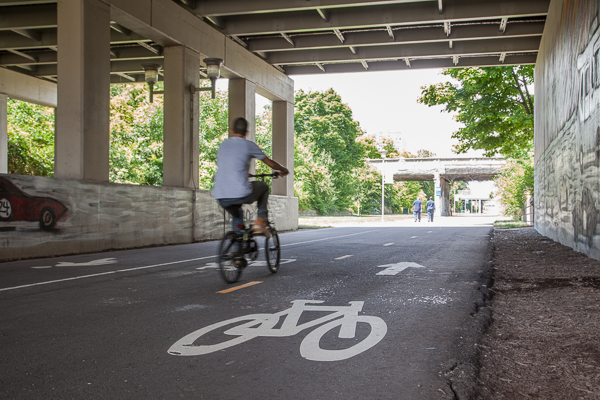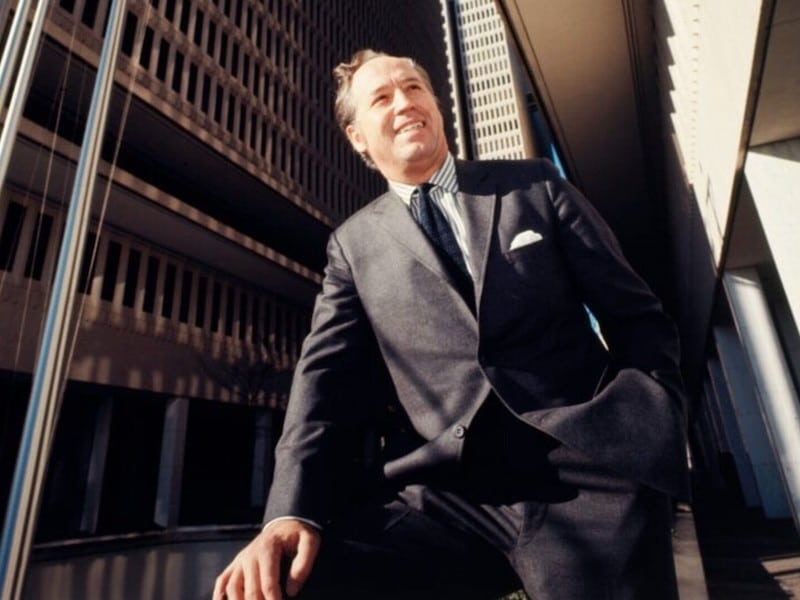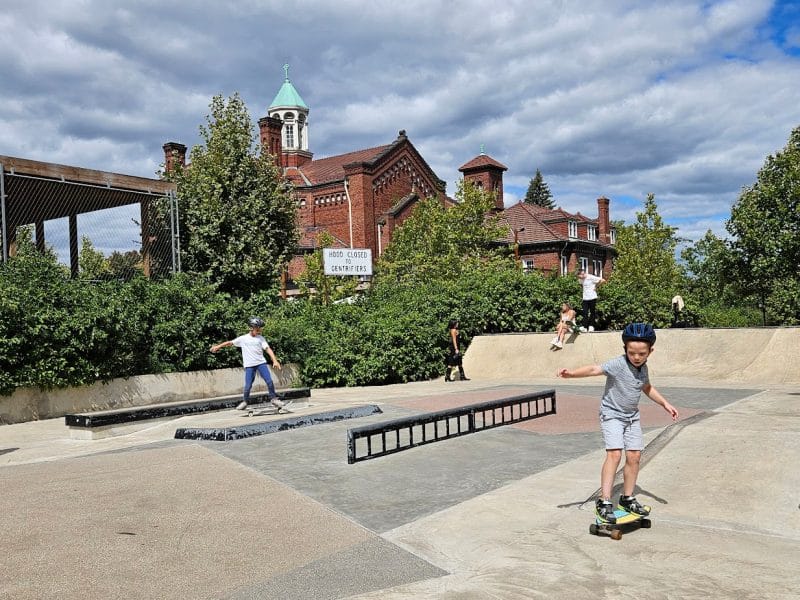Detroit’s new bike lanes have sparked controversy. What’s next?
Bike lanes have become a lively topic of debate in Detroit of late, with the city holding a series of community meetings to gather feedback on how best to go forward with them. Given all the complaints, how will the city respond?

Detroit’s cycling infrastructure has come a long way since 2007.
Back then, there were only around 13 miles of bike trails set down in Detroit; today there are over 240 miles of lanes and trails crisscrossing the city, including paths on on Belle Isle and the Dequindre Cut, a former railroad underpass that’s now an eye-catching cycling and pedestrian thoroughfare. And plans are in the works to add many more, including the completion of the 26-mile Inner Circle Greenway, a series of non-motorized pathways connecting the city.
Recent years have also seen the emergence of protected lanes, which have a physical barrier separating bicycles and motor vehicles, on streets like Cass Avenue.
Despite all this seemingly positive news, bike lanes have become a lively topic of debate in Detroit of late, with the city holding a series of community meetings to gather feedback on how best to go forward with them. The rumblings have been loud enough that Mayor Duggan even reportedly considered putting the city’s bike lane program on ice.
Given all the complaints about new bike lanes from cyclists and drivers alike, how will the city respond?
Expanding the network
Things really started to change for Detroit’s bike culture in 2007. That year, the Detroit Greenways Coalition (DGC), a local organization dedicated to making the city more bike- and pedestrian-friendly came into being, was founded and started advocating for cyclists.
In 2008, Detroit’s City Council laid the groundwork for today’s cycling network (thanks to pressure from DGC and other groups) when it passed a non-motorized plan that had been developed earlier by the city but had been gathering dust. And things really took off after 2014, when Ron Brundidge, Detroit’s director of the Department of Public Works (DPW), and other city officials traveled to Copenhagen, Denmark, a city known for its cycling infrastructure.
“Mainly my focus at that time—and not that it’s gone away—was ensuring the road was maintained for safe and efficient vehicular traffic movement,” Brundidge says. “I came back with an appreciation for how the infrastructure needs to be envisioned not just for use by motorists.”
Following that trip, the DPW director vowed to begin installing lanes that physically separated bikes and motorists.
Road rage
And that brings us to the city’s new protected bike lanes, which have some folks fired up.
The city constructed its first protected bike lanes along a short stretch of East Jefferson Avenue near the border of Grosse Pointe Park in 2015, and is currently in the process of expanding it. Last year, high-profile protected bike lanes with bollards and colorful rectangles of bright green paint popped up on Cass Avenue.
But both projects have run into hiccups. Some local cyclists have been dissatisfied with the design and maintenance of the Cass lanes. And work on an extension of protected lanes along East Jefferson ended up being stuck in a half-constructed limbo over the winter to the confusion of motorists and cyclists alike.
“I’m constantly afraid of being hit by doors [on Cass],” says Patience Young, a cyclist who lives in Detroit’s Poletown neighborhood. “Cyclists can’t see what’s going on in the street and the cars can’t see them leading to more accidents on the corners.”
Although she’s been less than thrilled with their implementation on Cass Avenue, Young says she does like the lanes on big roads, especially when they have planters—rather than the vertical posts known as bollards—to help with visibility.
Speaking more generally about the city’s bike network, Jenny Capella, who lives in Detroit’s Chadsey-Condon neighborhood, says lane upkeep has been a real issue for her.
“They aren’t maintenanced properly in the winter. All of the road snow is pushed into the lanes. In the summer, you have all of the shards of metal and car parts to dodge as well as messed up scary drainage holes.”
Longtime Detroit resident Alisa Brown concurs with Capella about the importance of maintenance. “There’s so much trash and debris,” she says of the painted lanes on Livernois near her home. “It’s not safe for cyclists.”
Brown also feels more work needs to be done teaching motorists how to navigate the lanes. “I think they need to keep them, but they need to educate people with public service announcements like somebody saying: ‘Drivers, hey look, this is what you need to know about bike lanes.'”
Responding to the strong feelings about bike lanes right now, the city has been holding public meetings to address concerns and gather input. During an April 18 bike lane discussion at the Northeast Guidance Center, members of the local cycling community raised questions about cluttered and unmaintained lanes, frustrations with design and visibility issues, lackluster public education efforts, poor enforcement of motorists who illegally park in lanes and other topics. As the meeting was on the east side, those in attendance also voiced their frustration with stalled implementation of protected lanes on East Jefferson Avenue.
Janet Attarian, deputy director of Detroit’s Planning and Development Department, was remarkably forthright in responding to concerns about the Jefferson lanes.
“It’s not in good condition,” she said. “There was a hope we were going to get it done before winter and it just didn’t happen. That was poor planning on our part, and we apologize for it.”
Work on the East Jefferson lanes will resume this month, though Attarian cautioned that it would be a multi-year process, due in part to a need to also upgrade utilities on the street. In the immediate future, the layout will be something of an experiment, allowing planners to get more feedback about what works best for road users in the long-term. Permanent lanes are expected to be completed by 2021.
During the meeting, Brundidge stressed that his department is hearing cyclists concerns loud and clear and would be examining how to better maintain lanes across the city. Looking at the big picture, DPW will also be doing its best to create a bike network that makes more sense for the cyclists who use it.
“One of the things we’re looking at now as we take another step back,” Brundidge said, “is how do we develop a network that really makes the most sense and provides the biking infrastructure where it’s more likely to be utilized in a really effective and safe manner for folks that for whatever reason are choosing not to get around in an automobile.”
Rolling forward
While a lot of folks have been voicing concerns about Detroit’s implementation of bike lanes, there are still lots of cyclists who are unabashed fans of the network.
Zoe Hoster, a Detroit cyclist who works for General Motors, says she’s excited about the direction bike lanes are taking in the city right now. “I really appreciate our city leadership for having the vision for how Detroit can be less car-dependent and making it easier for people to get around however they choose, whether they rely on it for transportation or want to use it from time to time.”
With talk of new bike lanes being installed downtown and new protected lanes being built along Livernois Avenue, it’s unlikely that the debate around bike lanes is going to simmer down any time soon.
While Todd Scott, executive director of the Detroit Greenways Coalition, feels local cyclists are justified in asking for better design and maintenance of local bike lanes, he wants critics to know that the city of Detroit has been facing a steep learning curve as it moves very quickly to make protected lanes a reality in the city.
Thankfully, though, he says city officials are keeping an open mind about how to best move forward with the city’s bike network—and that better days are likely ahead for Detroit’s cycling community.
“A lot of what’s being built now is kind of a pilot design using these plastic posts,” he says. “Longer term, we want to get more of a European design, where they actually have curbs and better separation.
“We look forward to pushing through this period and getting to some real physically separated bike infrastructure.”






